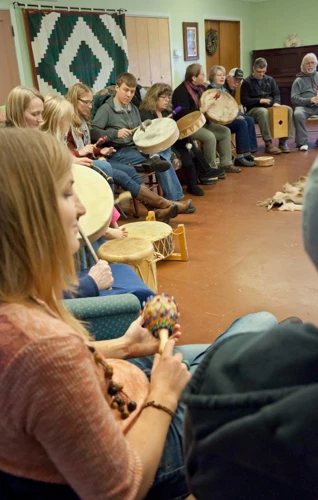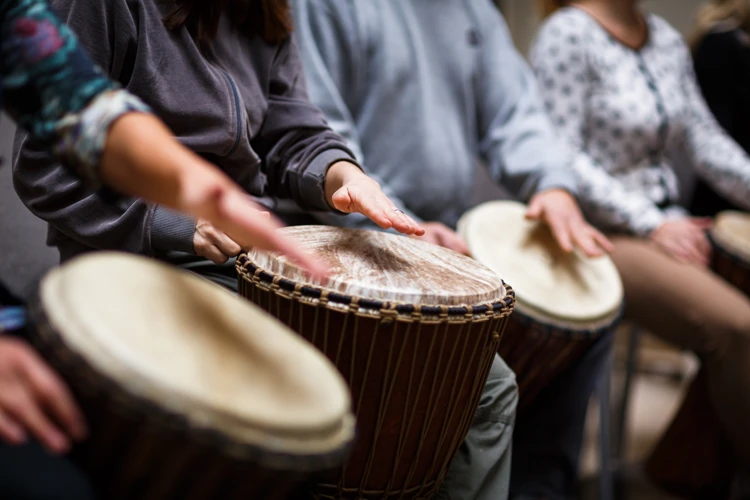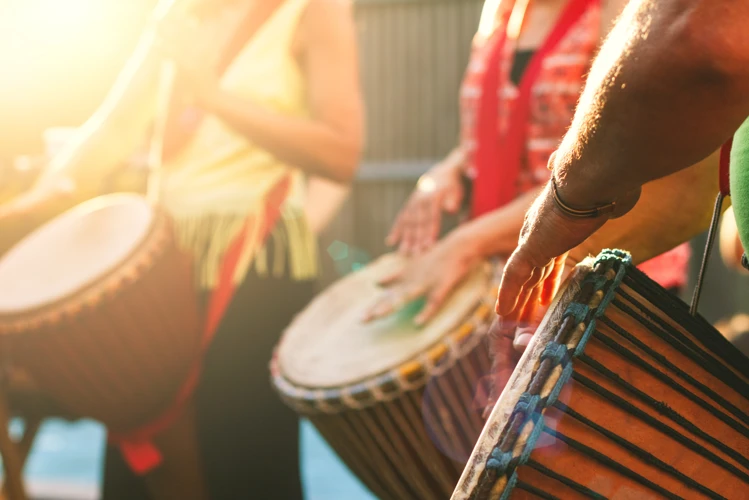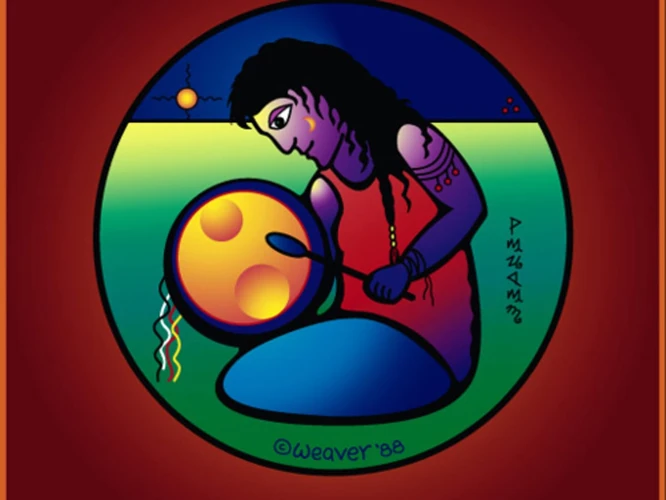As humans, we are always searching for ways to connect with each other and the world around us. And for some, this search takes them to shamanic rituals – traditional ceremonies that offer opportunities to connect with the spiritual realm. Among the many tools that shamans use for these ceremonies, drumming circles stand out as a powerful and unique practice. But what are drumming circles, and what makes them such an integral part of shamanic rituals? In this article, we will explore the significance of drums in shamanic cultures, the ways in which drumming circles enhance shamanic rituals, how to prepare for such a ceremony, and what to expect during one. So, if you’ve ever been curious about this ancient practice, grab a drum and join us on this journey into the heart of shamanic drumming circles.
What is a drumming circle?

When entering the world of shamanism, one may come across the term “drumming circle” and wonder about its meaning. This type of gathering is a fundamental component of shamanic rituals and holds a significant role in connecting individuals with their spirituality. A drumming circle involves a group of people coming together to play percussion instruments, usually drums, in a synchronized manner. However, it is more than just hitting a drum repeatedly. It is a powerful tool that enhances one’s connection to the spiritual realm, creating a heightened sense of awareness and community. Let’s delve deeper into the significance of drumming circles in shamanic cultures.
The significance of drums in shamanic cultures
Drums have played a significant role in shamanic cultures for centuries. They are often considered sacred instruments that have the power to connect individuals with spiritual realms and ancestors. The use of drums in shamanic rituals is believed to have a transformative effect on the mind and spirit by inducing altered states of consciousness, allowing individuals to access their inner selves and connect with the spiritual world. Here are some reasons why drums hold such a significant place in shamanic cultures:
| Connection to nature: | The sound of drums emulates the rhythm of the natural world, such as thunder and heartbeat, which creates a harmonious connection between the drummers and nature. It helps shamanic practitioners to connect with the earth, the universe, and the spirits of nature. |
| Tradition and history: | Drumming is an age-old practice that is deeply rooted in shamanic traditions, representing a powerful link to the past. Tribal communities across the world have used drums in their rituals for centuries, and the sound of the drumming often evokes cultural and historical memories. |
| Facilitation of healing: | In shamanic cultures, the drum is believed to have the power to heal physical and spiritual ailments. The uninterrupted rhythm of the drums is thought to stimulate the release of endorphins, creating a sense of euphoria and wellbeing that aids in the healing process. |
| Gateway to the spirit world: | Drumming is often used as a means to enter trance-like states, allowing shamanic practitioners to access the spiritual realm. The rhythmic sound of the drums can create a bridge between the physical and spiritual world, opening channels for communication with spirits, ancestors, and guides. |
The significance of drums in shamanic cultures is multifaceted, representing a range of cultural, historical, and spiritual values. The drums are seen as powerful tools in shamanic rituals that facilitate connection with nature, tradition, and the spirit world, making them an integral part of shamanic practices across the world.
How drumming circles enhance shamanic rituals

When it comes to shamanic rituals, the use of drums can play an important role in enhancing the experience. Drumming circles, in particular, are a powerful tool for connecting with spirits and creating a collective energy. Through the rhythmic beats of the drums, participants can enter into altered states of consciousness and deepen their sense of community with others. In this section, we will explore the ways in which drumming circles enhance the shamanic experience, including the creation of group energy, connecting with spirits, and strengthening community bonds. Let’s dive in and explore the transformative power of drumming circles in shamanic rituals.
Creating a group rhythm and energy
When a group of people come together to drum, they create a powerful collective and unified energy. This energy is achieved through the process of creating a group rhythm, which requires each individual to listen and sync up with one another.
During the process of creating a group rhythm, everyone needs to be aware of their own playing and how it fits into the music. This awareness fosters active listening, which in turn creates a sense of focus and attentiveness within the group. As the group rhythm develops, so does the energy that is being generated.
The beauty of a drumming circle is that it is completely improvised. Each individual is free to express themselves musically and contribute to the overall sound. As individuals become more comfortable with the group dynamic, they may begin to take on more complex rhythms or increase the tempo.
When the group is able to successfully create a rhythm, it’s as if the music is playing itself. The drums and percussion instruments blend together into a mystical and trance-like sound. This sound and energy can be transformative, helping individuals to release blockages and connect with their inner selves.
In essence, creating a group rhythm not only leads to a unified energy, but also builds a sense of togetherness and community. It’s an opportunity for individuals to come together and let go of their individual egos, allowing the group to create something greater than themselves.
Altered states of consciousness and connecting with spirits
During a drumming circle, the repetitive and rhythmic beat of the drums can induce altered states of consciousness that are conducive to connecting with spirits and entering into spiritual realms. These altered states of consciousness could range from a light trance and relaxation to a deeper meditative and shamanic experience.
In shamanic cultures, a shaman often uses drumming as a tool to establish communication with spirits and enter into altered states of consciousness. The drumming beat can create a bridge between the physical and spiritual realms, allowing the participants to connect with their inner selves, the natural world, and the spirits that inhabit it.
Several studies have shown that drumming can activate the theta brainwaves, typically associated with heightened creativity, intuition, and spiritual experiences. This brainwave state is similar to the state experienced during deep meditation or hypnosis, where the conscious mind becomes quiet, and the subconscious mind becomes more active.
During a drumming circle, participants can also experience anomalous experiences that could include visualizations, meaningful insights, emotional releases, or spiritual awakenings. These experiences can be catalyzed by the drumming beat, the energy of the group, and the intention set before the ceremony.
The connection with spirits during a drumming circle can be perceived as helpful and healing. It can provide spiritual guidance, support, and wisdom, and help overcome emotional or mental blocks. It is considered an essential aspect of shamanic practices, where the shaman acts as a mediator between the physical world and the spiritual realm.
Drumming circles offer a unique opportunity for participants to enter into altered states of consciousness and connect with spirits, providing insights and guidance into the deeper aspects of their lives.
Strengthening community bonds and trust
When people participate in a drumming circle, they are not just creating music together; they are also building a sense of community and trust. Here are some ways in which drumming circles can strengthen community bonds:
- Shared experience: By drumming together, individuals in the group share a unique and powerful experience. This experience can bring people closer together and create a sense of belonging within the community.
- Nonverbal communication: The act of drumming together requires a level of nonverbal communication. By listening to one another and adjusting their rhythm accordingly, participants can develop a sense of trust and cooperation.
- Breaking down barriers: Drumming circles often bring together people from different backgrounds who may not have interacted otherwise. Through the shared experience of drumming, participants can break down barriers and connect with those who are different from them.
- Empathy and compassion: When people drum together, they are creating a collective sound that can be felt in the body. This can create feelings of empathy and compassion towards one another, as the group becomes attuned to each other’s energy and emotions.
- Safe space: A drumming circle can provide a safe space for participants to express themselves creatively and emotionally. This can build trust within the community and allow individuals to feel more comfortable being vulnerable.
Drumming circles can be a powerful tool for building community and strengthening bonds between individuals. Through the act of drumming together, participants can develop a deeper sense of trust, cooperation, empathy, and compassion towards one another.
Preparing for a drumming circle

As with any shamanic ritual, preparation is key to ensuring a successful and meaningful experience in a drumming circle. The intricacies of the event require attention to detail and a certain mindset to fully embrace the experience. In this section, we will explore the necessary steps for preparing for a drumming circle, including the gathering of materials, setting intentions, and grounding practices. These steps will help you approach the drumming circle with a sense of purpose and openness, creating a space for deep connection and spiritual growth.
Gathering materials
One of the key aspects in preparing for a drumming circle is gathering the necessary materials to make the experience as effective and enjoyable as possible. Here are some items that can be helpful in setting up a successful drumming circle:
- Drums: The most obvious item you’ll need is a drum! There are a wide variety of drums available, including djembes, congas, and frame drums. If you don’t own a drum, consider borrowing one from a friend or renting one from a music store. It’s also possible to make your own drum, which can be a fun and rewarding process.
- Percussion instruments: In addition to drums, you can include other percussion instruments to add depth and variety to the sound. Shakers, rattles, bells, and chimes are all good choices.
- Chairs: While some people prefer to sit on the floor during a drumming circle, it’s a good idea to provide chairs for those who may have difficulty sitting on the ground for an extended period of time.
- Blankets: Having blankets available can be helpful for providing cushioning on the floor and keeping participants warm during the session.
- Water: It’s important to stay hydrated during a drumming circle, so make sure to have plenty of water available for participants.
- Incense or sage: Burning incense or sage can help create a calming atmosphere and clear negative energies from the space.
By having these materials ready and accessible, you can create an inviting and supportive environment for a drumming circle. Additionally, it’s important to make sure that everyone knows how to use the instruments and understands the basic guidelines and expectations for the session. With good preparation and communication, a drumming circle can be a powerful and transformative experience for all involved.
Mindset and intention-setting
One important aspect of preparing for a successful drumming circle is to cultivate a proper mindset and set clear intentions. Here are some steps to take:
- Ground yourself: Before you start thinking about the specific intentions you want to set, it’s important to center yourself and ground your energy. You can do this through a variety of practices, such as meditation, deep breathing, yoga, or simply taking a few moments to visualize yourself rooted to the earth.
- Reflect on your purpose: Spend some time thinking about why you want to participate in a drumming circle. What are your goals? Are you seeking healing or guidance? Are you hoping to connect with specific spirits or energies? The clearer your intentions, the more focused your energy will be during the circle.
- Choose your rhythm: Different rhythms carry different energies and have different effects on the body and mind. Consider what type of energy you want to cultivate and choose a rhythm that reflects that intention.
- Set your intentions: With a clear sense of purpose and rhythm, you can now set your intentions for the circle. Use affirmative language and imagine your intentions already manifesting in your life. For example, “I am open to receiving guidance and healing from the spirits. I trust in the wisdom of the universe and release all doubt and fear.”
- Share your intentions: If you feel comfortable, you can share your intentions with the group. This can create a sense of community and support, and may even help others connect with similar intentions.
By taking the time to cultivate a proper mindset and set clear intentions, you can maximize the benefits of your drumming circle experience. Remember to trust in the power of the rhythms and the wisdom of the spirits, and be open to whatever comes your way during the circle.
Grounding and centering practices
Before beginning a drumming circle, it’s important to engage in grounding and centering practices to create a safe and intentional space for the group. Here are some practices that can help:
- Breathing exercises: Take a few deep breaths, breathing in for a count of 4, holding for a count of 4, exhaling for a count of 4, and pausing for a count of 4 before beginning again. This can help bring focus and calmness to the mind and body.
- Visualizations: Imagine roots growing from the bottom of your feet deep into the earth, connecting you to its grounding energy. Or envision a bright, protective light surrounding you, creating a shield from any negative energy.
- Movement: You can engage in gentle stretching or yoga poses, such as tree pose or mountain pose, to help you feel physically grounded and connected to the earth.
- Affirmations: Repeat positive, empowering statements to yourself, such as “I am safe, I am centered, I am connected to the earth.”
Using these grounding and centering practices can help calm the mind, release any anxieties or stress, and help the group approach the drumming circle with a clear and focused energy.
What to expect during a drumming circle
Entering a drumming circle for the first time can bring a sense of anticipation and wonder. As you sit amidst a group of individuals who share an interest in shamanic practices, you might wonder what to expect from this immersive experience. Our focus now shifts to understanding the group dynamics, facilitation style, and the power of synchronicity in a drumming circle. Let us explore the journey ahead and delve into the mystery of what lies ahead in this enriching encounter.
Group dynamics and facilitation style
In a drumming circle, the group dynamics and facilitation style play a crucial role in creating a safe and supportive environment for all participants. Below are some important aspects to keep in mind when facilitating a drumming circle.
- Building trust: As the facilitator, it’s important to create a sense of trust from the very beginning. You can do this by warmly welcoming everyone, setting clear guidelines for the circle, and encouraging participants to share their intentions for the ceremony.
- Encouraging participation: Drumming circles work best when everyone feels comfortable actively participating. As the facilitator, you can encourage participation by inviting everyone to join in, regardless of their skill level, and offering guidance and support as needed.
- Paying attention to the group: It’s essential to be attuned to the energy of the group throughout the drumming circle. This means observing the dynamics between participants and adjusting the facilitation style accordingly. For example, if the group seems hesitant or disconnected, you might try leading a call-and-response rhythm or encouraging participants to make eye contact and smile at each other.
- Creating a sense of community: The drumming circle is an opportunity to create a community where everyone feels connected and supported. As the facilitator, you can foster a sense of community by encouraging participants to play together and helping everyone feel valued and heard. You might also facilitate opportunities for participants to share their experiences or insights.
By paying attention to group dynamics and adopting a supportive facilitation style, you can create a drumming circle that enhances shamanic rituals and strengthens community bonds.
Synchronicity and the power of the group
When individuals come together in a drumming circle, they create a unique energy that is greater than the sum of its parts. This energy is fueled by the synchronicity of the group, where everyone is playing together in unison, following the same beat and rhythm.
Synchronicity is a powerful phenomenon where events, actions, and thoughts seem to be meaningfully connected, even if they have no logical explanation. In a drumming circle, synchronicity can manifest in different ways. For example, multiple drummers may drop out or join in at the same time without verbal communication, or the group may naturally shift to a new rhythm together without any direction from a facilitator.
This power of the group creates a shared experience where individuals may feel a sense of interconnectedness and unity. The drumming circle can act as a container for this experience, where individuals can explore and express their spirituality through rhythm and sound. As the group energy intensifies, individuals may enter into an altered state of consciousness, entering into a trance-like state that allows for deeper connection with spirits and emotions.
The synchronicity and power of the group create a unique experience that is difficult to replicate in any other context. The drumming circle provides a space for individuals to connect with themselves, each other, and the world around them in a powerful and transformative way.
Conclusion
After exploring the significance of drums in shamanic cultures and the ways in which drumming circles enhance shamanic rituals, it is clear that these gatherings offer a uniquely powerful experience. The creation of a group rhythm and energy, the connection with spirits, and the strengthening of community bonds are all enhanced by the power of the drum.
Preparing for a drumming circle involves gathering materials, setting intentions, and engaging in grounding and centering practices. These steps can help participants enter into a state of openness and receptivity to the experience.
During a drumming circle, group dynamics and facilitation style play an important role in creating a safe and inclusive space. The power of synchronicity can also be felt as participants enter into a shared experience.
Overall, the use of drumming circles in shamanic rituals offers a rich and transformative experience. Whether participating in a circle for spiritual growth, healing, or simply for the joy of drumming, there is much to be gained from this ancient practice. As with any spiritual practice, it is important to approach it with an open mind and heart, and to remain respectful of the traditions and cultures from which it originates.
Frequently Asked Questions
What is the origin of drumming circles in shamanic cultures?
Drumming circles have been used in shamanic cultures around the world for thousands of years, with origins in Africa, Native America, and other parts of the world.
Do you need to have experience playing drums to participate in a drumming circle?
No, anyone can participate in a drumming circle regardless of their level of experience. The focus is on creating a group rhythm and energy, not individual performance.
What types of drums are used in drumming circles?
A variety of drums can be used including frame drums, djembes, congas, and hand drums. In some traditions, specific drums are used for specific purposes.
Can you attend a drumming circle if you don’t identify as being part of a shamanic culture?
Yes, drumming circles are open to anyone interested in exploring the power of group rhythm and connecting with the spirit world.
Does drumming circle always involve a shaman or spiritual leader?
No, while some drumming circles may be led by a shaman or spiritual leader, others may be lead by anyone with experience in leading group rhythms.
How long do drumming circles typically last?
The length of a drumming circle can vary, but typically ranges from 30 minutes to an hour or more.
How can I find a drumming circle in my area?
You can search online for local drumming circles or check with spiritual or community centers in your area.
What should I wear/bring to a drumming circle?
Wear comfortable clothing and shoes, and bring your own drum or percussion instrument if you have one. Some circles may also provide extra drums or instruments for participants to use.
Are drumming circles safe for people with certain medical conditions?
While drumming circles are generally safe for most people, it’s always a good idea to consult with a medical professional before participating if you have any concerns.
Can drumming circles be done virtually?
Yes, with the rise of virtual gatherings, many drumming circles have started to take place online, allowing people from all over the world to connect and play together.








